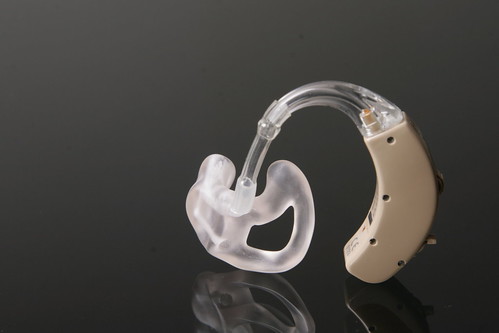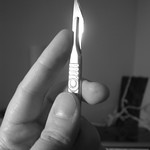 |
Photo license:    Some rights reserved Some rights reservedImage source |
There are also typical causes, which include aging, excessive noise exposure, and toxic medications. What many hearing loss patients do in order to regain their ability to hear sounds is to use hearing aids. Since many individuals have a lot of questions about the use of a hearing aid, we will go over some of the most common and we will provide reliable and simple answers.
Q: How do I recognize that I might be having hearing loss problems?
A: Generally, hearing loss begins gradually without any discomfort. To determine whether you are experiencing hearing loss, a few questions that you may ask yourself are:
1. Do I repeatedly ask people to repeat what they said?
2. Am I experiencing difficulty in following a conversation in a small group?
3. Is it hard for me to understand the speaker if he is not in front of me?
4. Am I struggling to hear things when I am in crowded places (e.g. restaurants, malls)?
5. Do I prefer a louder volume than others?
6. Am I experiencing difficulty in conversing over the telephone?
If you have answered yes to most of these questions, then it is possible that you are suffering from hearing loss.
Q: Who should I see when I have developed hearing problems?
A: You can visit one of these professionals specializing in ear problems:
1. Otolaryngologist – A surgeon who specializes in ear, nose and throat problems.
2. Audiologist – A health professional that identifies and measures hearing loss.
3. Hearing Aid Specialist – A licensed professional who checks one’s hearing, evaluates it, and fits a hearing aid.
These professionals would identify whether you are suffering from a hearing loss and will tell you which type of hearing loss you have.
Q: What are the types of hearing aids that I could use?
A: There are three types of hearing aids that are available in the market today:
1. CIC or completely-in-the-canal
2. ITE or in-the-ear
3. BTE or behind-the-ear
Q: How should I choose the right hearing aid for me?
A: Knowing the degree and type of your hearing loss is the major factor in determining the hearing aid that best fits your needs. Other factors include personal preference and lifestyle.
Q: Does using a hearing aid bring back my full abilities to hear?
A: Technically, it does not. They would only make sounds available to you through modified electrical signals but would not restore your hearing back to normal.
Q: Where can I purchase a hearing aid?
A: Hearing aids are available from different sources, which are operated by Hearing Instrument Specialists and licensed professionals (e.g audiologists, otolaryngologists, hearing aid specialist).
Q: Are there other devices available to treat hearing loss?
A: There are other devices that could complement the use of a hearing aid, such as devices that you could connect to televisions or stereos to make it easier for you to hear. Some alerts (e.g doorbells, smoke detectors, and alarm clocks) could have other signals that could be seen or felt.
About the author:
Ernest Poh founded The Hearing Centre Pte Ltd. The Hearing Centre is your one-stop centre for complete hearing aids and hearing conservation services. Ernest has been fitting hearing devices since 2004. Visit his website at http://thehearingcentre.sg to learn more about the different types of hearing aids and the possible causes of hearing loss.
 |
License: Creative Commons image source |
A small device which is capable of amplification and modulation of the sound, technically electronic acoustic and designed to fit behind the wearer’s ear can be termed as Hearing aid. Previously these devices were termed as ear trumpets. These hearing aids are used by different patients and also by professionals especially by the spy agencies. The ear is a very sensible and vital sense organ which is responsible for hearing and also results in keeping body balance. People facing hearing loss are in very much need to use these hearing aids. These aids deliver the sound of the inner ear of the user by more amplification and thus the user can hear the sound clearly. There are different types of hearing aids following different mechanism in their operations. But people who don’t want to sacrifice the problem for anything often raise the question what are the top hearing aids? There is a huge list of aids. Let us see what the top hearing aids are.
BTE or behind the ear:
these types of hearing aids are sealed in a plastic case and rests behind the ear. The plastic case is connected to the earpiece of clear tabbing. The plastic case contains microphones, loudspeakers, electronics control, battery etc. The sound is routed acoustically from the instrument to the ear. These types of aids can be used as mild to profound hear loss and generally used by the children’s as it has the capability to get adjust with different types of ear moulds and can be replaced as the child grows. It can be easily cleaned and handled and they are relatively sturdy. To answer the question what are the top hearing aids, it comes the first.
Mini BTE aids:
This is a different type of BTE aid and named as a mini BTE aid. It is much smaller than normal BTE. The aid is connected to the ear canal by almost an invisible tube. These particular aids are fixed in the ear more easily as it is smaller than BTE. This hearing aid is also used as traditional ear mould and only results in reduced occlusion but also boosts comfort level and thus reducing feedback and addressing cosmetic concerns.
ITE or in the ear aids:
These are very small devices and get fitted in the Concho which is the outer bowl of the human ear. They are almost invisible and sometimes visible when standing face to face with someone. The aid is designed with nice technology. A tube is primarily placed to offer pressure equalization and various styles of tube can be used to influence and prevent feedbacks and these types of hearing aids are not recommended for children as the ear mould cannot be replaced with the growth of the child and it is hard to clean also. These hearing aids are made up of silicone type materials and thus it can be routed cordlessly to FM radio systems for example, with an FM receiver worn on the body, associated with an induction neck-loop that transmits the signaling audio from the FM transmitter. These aids are easy to handle for professionals.
ITC or IN the canal aids:
These types of aids are connected in tiny a case that is partly or completely fitted in the ear canal. These aids are the smallest hearing aids and deliver cosmetic as well as listening advantages.
Therefore, to there are many solutions of the question what are the top hearing aids and people can choose one of convenience.
Ema Watson writes on various healthcare subjects. She loves sharing some knowledge on Top Hearing Aids technology on behalf of the Hearing Excellence a company that provides services to the hearing impaired people.
Cricothroidotomy
 |
| Image source : http://www.flickr.com/photos/andreweason/268627274/ |
Cricothroidotomy is an emergency medial procedure in which an incision is
made through skin and cricothyroid membrane to obtain the airway when other
procedures e.g. orotracheal,endotracheal and laryngeal mask airway are not
effective or contraindicated.Cricothyroidotomy is life-saving in many
conditions so healthcare providers must know this procedure.It is also known
with other names such as cricothyrotomy, throcricotomy, coniotomy and emergency
airway puncture.
INDICATIONS
Cricothyrotomy is mostly the last option for obtaining an airway but it is
indicated in the following conditions:
* Oral, nasal and pharyngeal hemorrhage
* Facial trauma
* Laryngospasm
* Emesis
* Cervical spine trauma
* Oropharyngeal edema
* Obstruction of airway by foreign body
CONTRAINDICATIONS
Cricothrotomy cannot be performed in children below 10 years at any condition.Some
use 12 years as the cutoff age.It is also not performed when person is
suffering with acute laryngeal infection.It should not be done when the anatomy
of the cricothyroid membrane is altered by pathology such as tumors.
EQUIPMENTS
You should have following equipments to perform the cricothyrotomy:
* Sterile gloves
* Antiseptic solution (alcohol)
* Local anesthetic
* Scalpel
* Scalpel handle
* Endotracheal tube
* 10 cc syringe
* Stylet
* Water soluble lubrication
* Sterile dressing
* Tape
* Sthethoscope
PROCEDURE
1- Place the patient in supine position.
2-Locate the thyroid cartilage and cricothyroid membrane.
3-Clean the skin with alcohol and let it dry.
4-Anesthesize the area by local anesthetic.
5-Stabilize the thyroid cartilage with non dominant hand and make a
vertical incision of about 2.5 cm over the cricothyroid membrane.
6-Check the cricothyroid membrane and make a horizontal incision through
it.Remember not to go more than 0.5 inch deep to avoid the oesophagus
peroration.
7-Open the incision by using inverted scalpel handle.
8-Insert the endotracheal tube (8 mm) down into the trachea.
9-Inflate the tube cuff with air by using the 10 cc syringe.
10-Auscultate over lungs and stomach and check the chest movements to
confirm the position of endotracheal tube.
11- Fix the tube by using tape.
12-Apply sterile dressing.
COMPLICATIONS
Complications of cricothyrotomy are very rare if it is performed by an
experienced person.Following complications may occur:
* Hemorrhage
* Oesophageal perforation
* Tracheo-oesophageal fistula
* Subcutaneous emphysema
* Thyrohyoid membrane incision
* Dysphonia
PATIENTS EDUCATION
You will need to inform your patient if he is conscious that it is a very short procedure and will take less than 5 minutes.Explain the whole procedure and its complications to your patient.

